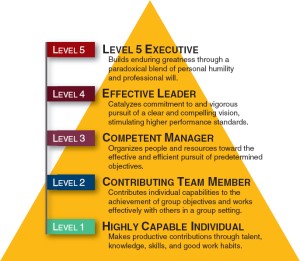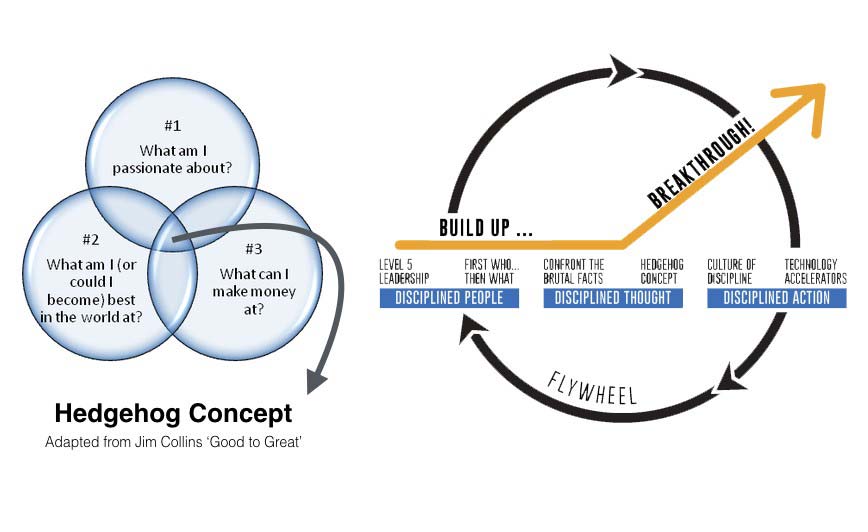Good to Great (The Definitive Summary) by Jim Collins
Can a “Good” Company Make The Transition To Be “Great”? Find Out How...
This Good to Great book summary will show you everything you need to know about the business model for turning a good, average or even mediocre company into a great one.
Firstly, I’ll go through the business model and bring all the theory together in an easy, useful way.
Then, I’ll help you break through the barriers to greatness. Stop holding back- Go Good to GREAT.
Sound good?
Let’s dive right in…

DISCLAIMER: I know Good to Great was published many years ago, however, I assure you these principles are timeless.The 6 Things That Will Make a Company Great.

Overview
“Good to Great” is one of those books you quoted just about everywhere, and for good reason.
The Author Jim Collins’s and his 21-person strong research team spent 5 years meticulously reading 6,000 articles and producing 2,000 pages of interview transcripts to bring you this classic best seller that endures the sand of time.
In fact when I read this book I was shocked to see it was published 15 years ago. After reading it, I know why this is an all time classic MUST READ.
Want to know the answered, “What common characteristics are shared by companies that made the change from good to great?”
This is a must for all entrepreneurs book shelves.
Point 1
Level 5 Leadership
If you said, “hey, if Level 5 is the best, then there must be levels 1 through 4” you’d be right.
Here they are:


- If you are a highly capable individual, then you are a Level 1;
- If you are a contributing team member, you are a Level 2;
- If you are a competent manager, you are a Level 3.
- If you are an effective leader, you are a Level 4; and finally.
- If you build a paradoxical blend of humility and professional will, you are a Level 5 executive.
Still not sure if you are a Level 5 or not?
Here are some clues.
- If you have ambition for your company rather than yourself, you are a Level 5.
- If you have a compelling modesty, you are a Level 5.
- If you have an unwavering resolve to do what must be done, you are a Level 5.
If it turns out that you aren't a Level 5 leader, or don't want to be, this book is not for you.
Point 2
First Who, Then What
In the alphabet of Good to Great, Who, always comes before What.

In the alphabet of Good to Great, Who, always comes before What.
Before you create a vision, strategy, structure, and tactics, you must first get the right people in your organization.
Collins uses the analogy of the bus. You need to get the right people in the right seats on that bus before you know where you are going to drive it.

Just for the record, I vote to drive that bus straight to the bank – right where the money is.
Level 5 leaders, as it turns out, have a relentless focus on getting the right people on board. From my own experience, this is the number one critical aspect for any business owner if they want to grow their business, reduce their stress and ultimately earn more money!
One of the reasons they do this, is they know that someday they are going to kick the bucket – like Jack Nicholson and Morgan Freeman from that terrible movie – and then who’s going to steer the ship?
Why, the people on the bus, of course. Level 4 leaders who rely on their abilities and sheer genius to get things done are what Collins calls a “genius with a thousand helpers.”
Here’s how to be rigorous with your people decisions:
- When in doubt, don’t hire. Limit growth based on your ability to attract enough of the right people.
- When you need to make a change, act. First, make sure that they aren’t placed in the wrong seat though. You’ll often find that some of your team members are better suited for other roles in your company.
- Put your best people on your biggest opportunities. It’s very tempting to put your best people on your best problems. Don’t!
- If you are going to sell off your problems, don’t sell off your best people with it.
Point 3
Confront the Brutal Facts
Having a vision is great, but great organizations continue to combine vision, with the brutal facts of reality.

Think of Britain in World War II. In the middle of being bombed to oblivion by the Nazis, and with most of Europe and North Africa under German control, Churchill had this to say:
“We shall fight in France, we shall fight on the seas and oceans, we shall fight with growing confidence and growing strength in the air. We shall defend our island, whatever the cost may be. We shall fight on the beaches, we shall fight on the landing grounds, we shall fight in the fields and in the streets. We shall fight in the hills. We shall never surrender.”
Churchill knew that if he sugar-coated the situation, everybody would know that he was full of BS.
It’s as if he were saying, “ok, here’s the deal. Things are really bad right now. and, they might even get worse. But here’s how we are going to work through this.
Here’s how we are going to win.”
Collins calls this the Stockdale Paradox, a Vietnam veteran, and a POW. Here’s his paradox:
You have to retain faith that you will prevail in the end, and confront the brutal facts of reality, whatever they may be.
Of course, having unwavering faith without the brutal facts isn’t going to do you much good. So here’s how you build a culture where the nasty facts that people don’t like to talk about, are front and center:
- Lead with questions, not answers. Ask “why?”, “why?”, “why?” a thousand times, “Why?”
- Engage in dialogue and debate, not coercion. Don’t assume that you know everything- You don’t! You’ll be amazed at what you can learn from the people around you if, you invite them to share and ask for their opinions.
- Conduct autopsies without laying blame. Every time you make a mistake, look at it. Probe it. Learn everything you can about it. Most importantly, don’t place blame. Focus on what you are going to do better the next time, instead.
- Build in red flag mechanisms that turn “information” into “information that can’t be ignored.”
Are you talking about the tough stuff or are you an ostrich?
Point 4
The Hedgehog Concept
Quick pop quiz: are you a hedgehog or a fox? Here’s a hint:

The fox knows many things, and the hedgehog knows one big thing.
Foxes pursue many things at the same time and see the world in all its complexity.
Hedgehogs, on the other hand, simplify a complex world into a single, organizing idea. A simple principle that unifies and guides everything.
Least you think that hedgehogs are dumb and a little bit slow, here are a few hedgehog ideas.
Einstein’s E=MC2. Adam Smith’s pin factory and invisible hand.
The truly great companies – in one way or another – were hedgehogs.
Now, I’d argue that we are on the brink of such dramatic change in the business world that everybody should be thinking about this. Even if you’ve gone through this process 2 years ago, it’s probably time to take another look at it.
What is a hedgehog concept?
It’s a simple, crystalline concept that flows from a deep understanding of the following 3 things:
- What you can be best in the world at. This is far different than a core competency, and really forces you to be honest with yourself. You’ll probably have to confront some brutal facts with this one.
As Collins puts it, a hedgehog concept is not a goal to be the best, a strategy to be the best, an intention to be the best, or a plan to be the best. It’s an understanding of what you can be the best at. - What drives your economic engine.The biggest thing in your engine is the denominator in this equation: Profit per X.
It could be profit per store, or profit per visit, or many other things.
This is a critical question to be asking yourself. Spend some time on this; it’s an important point!
- What you are passionate about?Although the hedgehog concept seems to be a hedgehog concept itself, don’t fret about figuring it out overnight.It took four years, on average, for the Good to Great companies to get to their hedgehog concept.
Collins also talks about setting up a council to help move your organization through, and towards, the hedgehog concept.
Rather than a council, you should probably grab as many smart people as you can (preferably more intelligent than you) and have a go at it. If someone is reciting, Good to Great quotes, just make sure to listen.
Listen when somebody tells you the brutal facts.
Point 5
Culture of Discipline
This is an obvious one, so we won’t spend much time on it.

Essentially, you need a company of self-disciplined people who take disciplined action, fanatically consistent within the three circles:
- Disciplined people;
- Disciplined thoughts; and
- Disciplined action.
Getting this done requires a seemingly contradictory rule.
People should work within the confines of a system, but people should have the freedom and flexibility to do what needs to be done, within the framework of that system.

Point 6
Technology Accelerators
According to Collins, here’s what you need to know about technology.

When used right, technology becomes an accelerator of momentum, not the creator of it.
The Good to Great companies didn’t begin their journey with pioneering technology, for the simple reason that you can’t make good technology until you know which technologies are relevant.
Which are those?
Those, and only those, that point directly to the three intersecting circles of your hedgehog concept.
Seeing that we are in the middle of an enormous change in how technology is being used in business, I think this is highly relevant commentary.
Somebody has probably told you that you need to be using Twitter, or that you need to upload a video on YouTube. You may even be reading the Good to Great ebook, but;
Remember, don't be motivated by a fear of being left behind. Take the time to see how you can use these new technologies to achieve business results.
But also remember this: there is a tremendous opportunity to change how you do business with these technologies.
Now It’s Your Turn…
And now I’d like to hear from you:
What’s your #1 takeaway from today’s Good to Great book review?
Maybe you have a question.
Either way, I’ll be personally replying to comments and questions that come in.
Now It’s Your Turn…
And now I’d like to hear from you:
What’s your #1 takeaway from today’s Good to Great book review?
Maybe you have a question.
Either way, I’ll be personally replying to comments and questions that come in.


